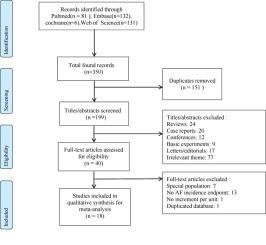Ecotoxicology and Environmental Safety ( IF 6.2 ) Pub Date : 2020-11-01 , DOI: 10.1016/j.ecoenv.2020.111508 Chao Yue , Fan Yang , Fengwei Li , Yingtai Chen

|
Background
Atrial fibrillation (AF) is the most common sustained cardiac arrhythmia with several risk factors. Recent studies have suggested that the exposure to air pollutants may increase the prevalence of AF, we evaluated those studies systematically to better elucidate the correlation between exposure to air pollution and AF.
Method
We conducted a systematic review of publications using PubMed, Embase, the Cochrane library and Web of Science to explore the association between air pollutants and AF within the general population. The chosen studies were published until 7 July 2020. According to different study designs, we divided the outcomes into “short-term-exposure group” and “long-term-exposure group” for each pollutant. We used I2 statistics and Q-test to examine statistical heterogeneity, and sensitivity analysis to exclude the heterogeneous study. Fixed or random-effect model was used to combine the effects. Final result was presented as the OR and 95% CI of AF prevalence for every 10 μg/m3 increase in the concentration of PM2.5 and PM10;10 ppb increase in the concentration of SO2 ,NO2 ,O3; and 1 ppm increase in the CO concentration.
Results
Our analysis contain 18 studies. Underlying short-term exposure effect, for each increment of 10 μg/m3 in the PM2.5 concentration, the combined OR of AF prevalence was 1.01(1.00–1.02), for PM10 was 1.03(1.01–1.05). For a 10 ppb increment in the concentration of SO2, NO2, and O3 was 1.05(1.01–1.09), 1.03(1.01–1.04), and 1.01(0.97–1.06), respectively, for a 1 ppm increase of CO concentration was 1.02(0.99–1.06). Underlying long-term-exposure effect for each increment of 10 μg/m3 in the PM2.5 concentration; the combined OR of AF prevalence was 1.07(1.04−1.10) and that for PM10 was 1.03(1.03–1.04) For a 10 ppb increment in the NO2 concentration was 1.02(1.00–1.04).
Conclusion
Our meta-analysis indicated that all air pollutants exposure had an adverse effect on AF prevalence in general population.
中文翻译:

普通人群中空气污染物与房颤之间的关联:系统评价和荟萃分析
背景
心房颤动(AF)是最常见的持续性心律不齐,有多种危险因素。最近的研究表明,暴露于空气污染物可能会增加房颤的发生率,我们系统地评估了这些研究,以更好地阐明暴露于空气污染与房颤之间的相关性。
方法
我们使用PubMed,Embase,Cochrane图书馆和Web of Science对出版物进行了系统的综述,以探讨一般人群中空气污染物与AF之间的关系。选定的研究发表至2020年7月7日。根据不同的研究设计,我们将每种污染物的结果分为“短期接触组”和“长期接触组”。我们使用I 2统计量和Q检验来检验统计异质性,而敏感性分析则排除了异质性研究。使用固定或随机效应模型来组合效应。最终结果表示为PM 2.5和PM 10浓度每增加10μg/ m 3,房颤患病率达到OR和95%CI; 10 ppb的SO 2,NO 2,O 3浓度增加;CO浓度增加1 ppm。
结果
我们的分析包含18个研究。在短期暴露效应的基础上,对于PM 2.5浓度每增加10μg/ m 3,AF患病率的组合OR为1.01(1.00-1.02),而PM 10则为1.03(1.01-1.05)。对于10 ppb的SO 2浓度增加,NO 2和O 3分别为1.05(1.01-1.09),1.03(1.01-1.04)和1.01(0.97-1.06),CO浓度每增加1 ppm浓度为1.02(0.99-1.06)。在PM 2.5浓度下每增加10μg/ m 3,潜在的长期暴露效应;AF患病率的组合OR为1.07(1.04-1.10),PM 10患病率为1.03(1.03-1.04),对于10 ppb,NO 2浓度增加为1.02(1.00-1.04)。
结论
我们的荟萃分析表明,所有空气污染物暴露均对普通人群的房颤患病率产生不利影响。











































 京公网安备 11010802027423号
京公网安备 11010802027423号